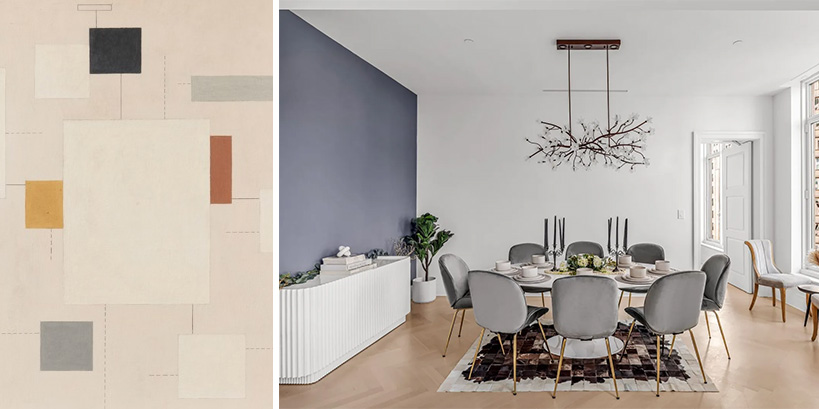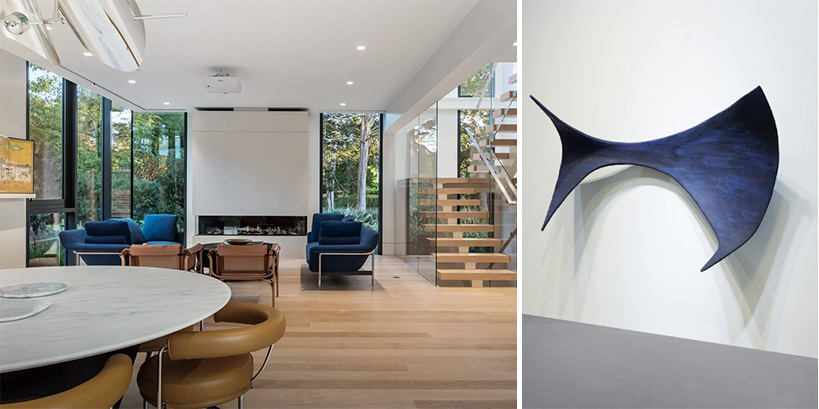
Cindy Shea – Sotheby’s International Realty – Bridgehampton Brokerage
Art can be complex or purposely inscrutable, making the complete “understanding” of a piece an impossibility. But that doesn’t mean you can’t notice and interact with the work—and there are three fundamental qualities any art scholar or historian will immediately identify.
First, the physical form; what medium or media is the work made with? Second, the content; what does it depict or communicate through image, color, shape, or symbol? And finally, the context; what factors have informed or influenced its creation?
Context has another facet—where is the artwork situated, and why? What does it accomplish in this space, and how does it dialogue with its surroundings? This is the context that knowledgeable collectors consider as they display statement art pieces in their homes, and here are six techniques they employ when deciding on the most impactful placements.
The Totality of Tonality

Kristen Wu and Allen Wu – Sotheby’s International Realty – Downtown Manhattan Brokerage
In painting, a hue refers to the color created by pure pigment. When mixed with white, it becomes tinted; when mixed with black, it becomes shaded. But tones—which come from the mixture of grays, composed of both black and white—bring great nuance to a work. Pay attention to these nuances, as seen in this Baumeister abstraction, and how they interact with neutral spaces such as this Tribeca apartment in the Four Seasons Hotel, where a gray-infused accent wall and furnishings provide intriguing convergences and contrasts with the colors in the work.
Shapes and Shadows

Cindy Shea – Sotheby’s International Realty – Bridgehampton Brokerage
Not all artworks lie flush against a wall. When a work plays with light, depth, and dimension in novel ways, juxtapose it with a space that likewise combines different lines, curves, and contours in different ways. That’s why a piece like this evocative Lerner would be well-situated in the open-concept family room of this stunning East Hampton estate.
Embrace the Elements

Kumara Wilcoxon – Kuper Sotheby’s International Realty
Nature is inherently calming, and artworks can help to embellish and emphasize natural elements in the living space—whether wood or stone, flowers or water. Here, it’s easy to picture how this color field by Erben complements this unique, ultramodern country home in Austin, which abounds with plant life, organic wooden paneling and accents, and earth tones.
Making Material Magic

Kay Smith – United Kingdom Sotheby’s International Realty
Sculptures have an indelible presence in space, foregrounding their texture and tactility as the defining features of their aesthetic composition. So when organizing decor around a piece like this captivating Choucair figure, pay close attention to the haptic qualities of the room’s varied surfaces to create an ambiance that’s as tangibly satisfying as it is visually appealing—as is the case with this gorgeously contemporary retreat in London.
Attention to the Details

Nicholas Pirzada – Sotheby’s International Realty – Brentwood Brokerage
An artwork, first and foremost, needs to suit the space where it’s situated—and then furnishings can be selected that correspond with the piece. When done correctly, the most subtle intricacies can become bold declarations; notice how the repeating images in this photographic work by Gilbert and George cultivate an illusion of reflectiveness that’s heightened by the furniture in this West Hollywood mansion, while stark geometry intensifies the black window frames.
Let the Outside Inside

Karen Heyman and Alan Heyman – Sotheby’s International Realty – Downtown Manhattan Brokerage
Sometimes, the best counterpoints to a work of art exist beyond the home itself. It’s not just the warm wooden interiors of this chic Brooklyn condo that enliven this jubilant Albers canvas, but the abundant sunlight and the historic brick and brownstone buildings across the bay.
Statement pieces are important focal points for a room, but they have to take priority. Fortunately, art is inherently lucid. If you’re willing to consciously look and listen, it will tell you what it needs in order to achieve its full potential.
This article originally appeared at https://www.sothebysrealty.com/extraordinary-living-blog/how-to-anchor-rooms-around-statement-art-pieces


 Facebook
Facebook
 X
X
 Pinterest
Pinterest
 Copy Link
Copy Link


